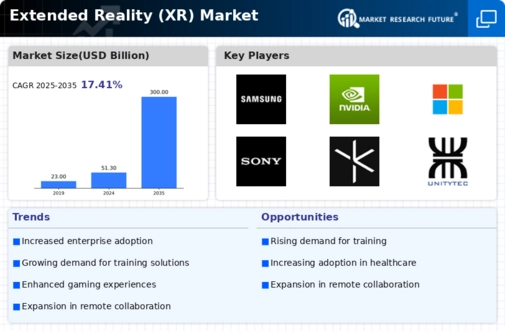Top Industry Leaders in the Extended Reality XR Hardware Market

A Competitive Landscape in the Extended Reality Hardware Market:
The Extended Reality (XR) hardware market, encompassing Virtual Reality (VR), Augmented Reality (AR), and Mixed Reality (MR) devices, is poised for explosive growth. This rapid ascent has attracted a diverse range of players, creating a dynamic and competitive landscape.
Key Players:
- Qualcomm Incorporated
- Accenture plc
- Unity Technologies
- Alphabet Inc.
- Adobe Inc.
- Northern Digital Inc.
- SoftServe Inc.
- Facebook Inc.
- Sony Corporation
Strategies Adopted by Key Players:
Established players like Meta (formerly Facebook) with its Oculus Quest headsets and HTC with its Vive series are aggressively pursuing market share expansion. Meta leverages its social media dominance to drive user adoption, while HTC focuses on high-end, enterprise-grade solutions. Sony, with its PlayStation VR2, targets the lucrative gaming segment. These established players often adopt similar tactics:
-
Product diversification: Offering a range of devices catering to different price points and needs. -
Content creation and partnerships: Investing in compelling VR/AR content and collaborating with developers to expand the ecosystem. -
Technological innovation: Continuously improving display resolution, field of view, and processing power to enhance user experience. -
Strategic acquisitions: Expanding capabilities through targeted acquisitions, like Meta's purchase of Beat Games, a VR fitness game developer.
Emerging Players and Disruptive Innovation:
New and emerging companies are challenging the incumbents with innovative approaches and niche offerings. For instance, Pico Interactive, a Chinese VR headset manufacturer, focuses on cost-effective solutions for the Asian market. DPVR, another Chinese player, specializes in standalone VR headsets for education and training. These companies capitalize on:
-
Cost-competitiveness: Offering lower-priced alternatives to established brands. -
Niche specialization: Catering to specific user segments with tailored features and experiences. -
Focus on emerging markets: Targeting regions with less brand saturation and higher growth potential. -
Agile development: Responding quickly to market trends and user feedback.
Key Factors for Market Share Analysis:
Analyzing the competitive landscape of the XR hardware market requires evaluating various factors beyond brand recognition and market share. Some crucial metrics include:
-
Technology: Features like resolution, field of view, refresh rate, and processing power significantly impact user experience and adoption. -
Content ecosystem: The availability and quality of VR/AR content are crucial for attracting and retaining users. -
Price point: Striking a balance between affordability and advanced features is essential for broader market penetration. -
Distribution channels: Partnerships with retailers, mobile operators, and other businesses can expand reach and accessibility. -
Target audience: Identifying and catering to specific user segments with tailored devices and experiences. -
Innovation: Companies continuously innovating and differentiating their offerings gain a competitive edge.
Industry Developments:
Qualcomm Incorporated:
-
Focus: Chipsets and processors for XR devices. - Latest Updates:
-
January 2024: Announced collaboration with Meta to develop new VR headsets powered by Snapdragon XR2+ Gen 1 platform. -
November 2023: Showcased new Snapdragon XR2+ Gen 1 platform with improved performance and power efficiency. -
August 2023: Announced expanded collaboration with Microsoft to develop XR solutions for HoloLens 3.
Accenture plc:
-
Focus: Consulting and advisory services for XR integration in businesses. - Latest Updates:
-
February 2024: Collaborated with Qualcomm and InterContinental Hotels Group on a pilot XR solution for event planning. -
October 2023: Launched the Metaverse Continuum, a framework for businesses to explore and adopt XR technologies. -
June 2023: Acquired Fjord, a design and innovation consultancy with expertise in XR.
